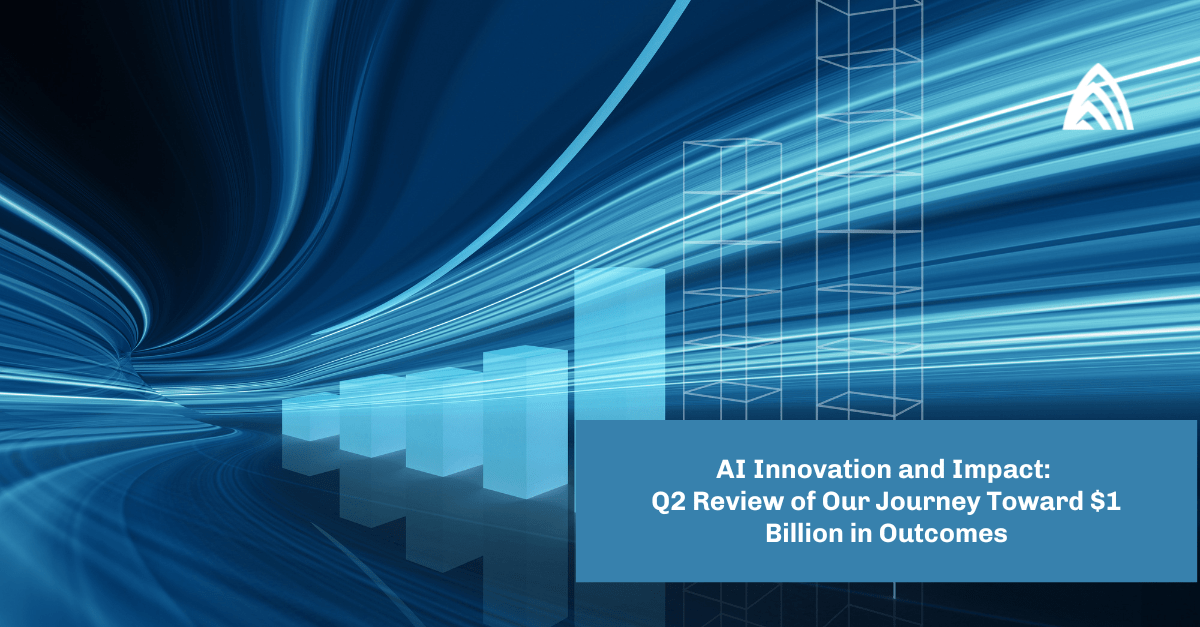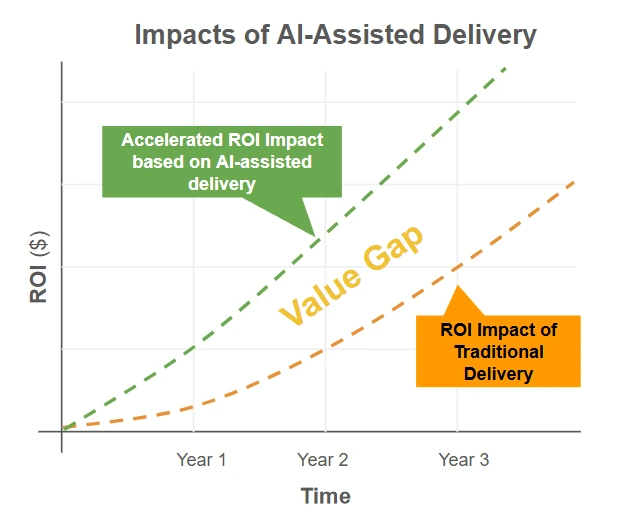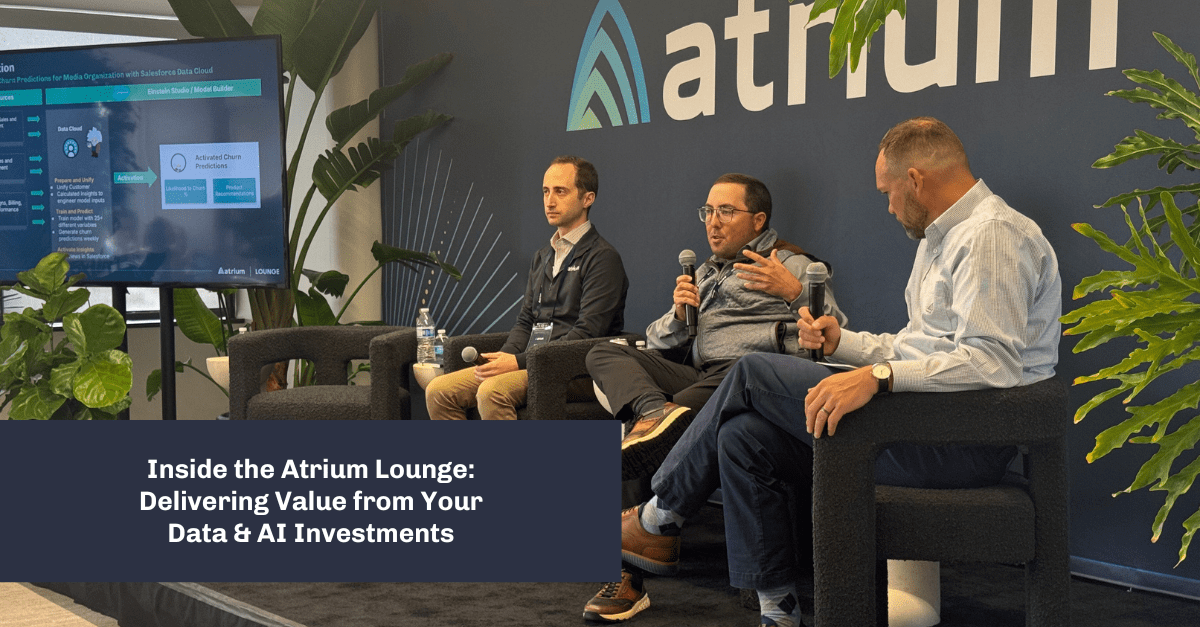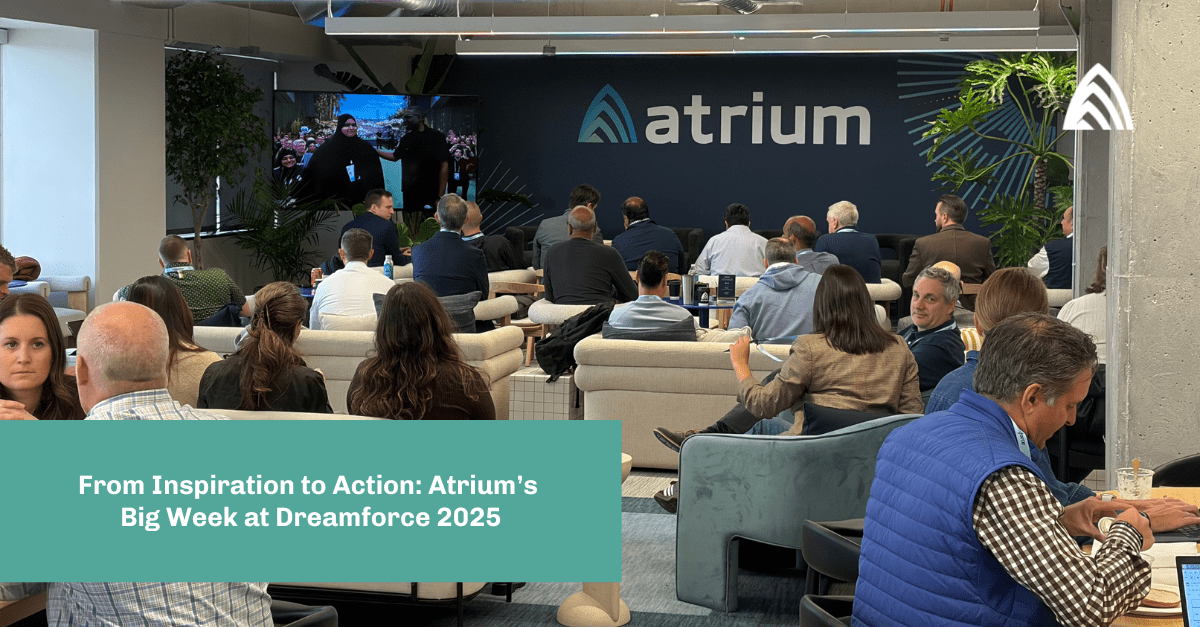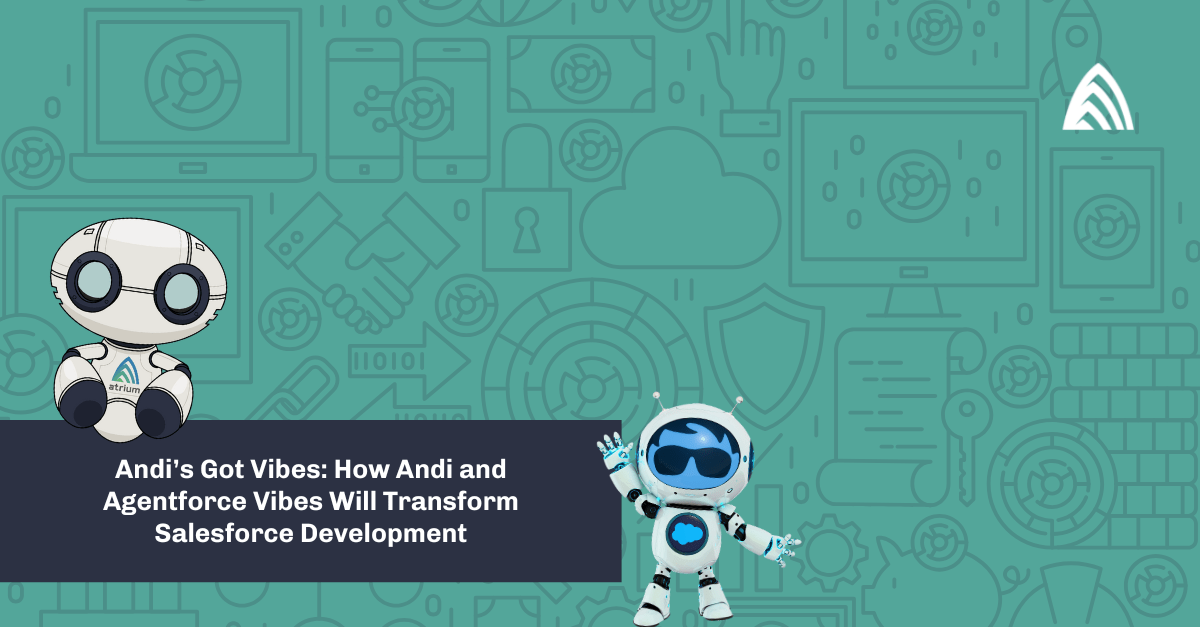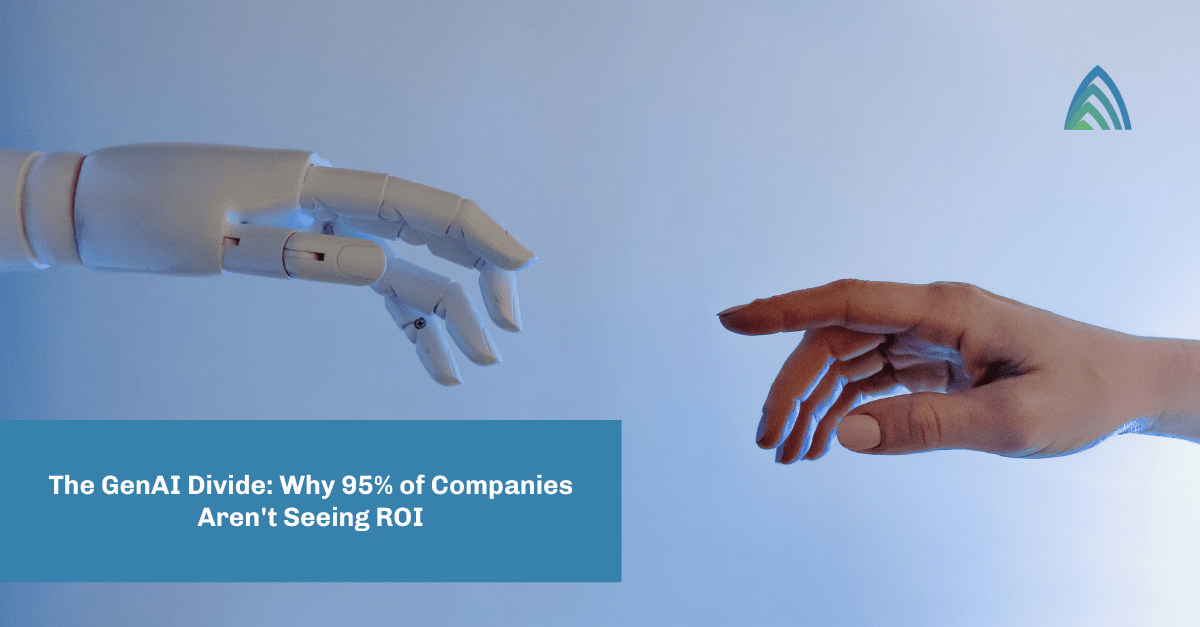2025 is zipping by, and for AI, a few months can be a lifetime of innovation. With the second quarter of 2025 coming to an end, it’s time to take another look at Atrium’s one billion dollar goal.
You can check out our interactive $1 Billion Outcomes Dashboard below. We’re tracking our journey to inventory over one billion dollars in projected customer ROI around AI development, and making good progress towards getting there.
How are organizations thinking about AI, and how has that shifted in the face of rapid AI innovation and expansion? This blog will discuss some of the biggest learnings as we’ve helped our customers think about the value that AI implementation can drive, where we’re seeing value, and introduce the concept of AI-assisted consulting services, which will fundamentally change how services are delivered.
Where we’re seeing big value
Much like the first quarter of 2025, much of the buzz around AI is around generative and agentic capabilities.
Predictive AI tools still have their place, though, and we’ve seen an uptick in organizations that seek to build out predictive capabilities that can be used to drive organizational decision making, streamlined customer service, and proactive problem solving.
Common use cases include:
- Customer acquisition: Predicting lead and opportunity conversion, and driving AI-based “next best actions” to facilitate more streamlined purchase behavior.
- Customer health: Predicting trends in customer health, cross-sell or upsell, and likelihood for existing clients to attrit in order to drive prescriptive strategies for managing customer relationships.
- Sales and demand forecasting & operations optimization: Smarter, more targeted frameworks for forecasting sales and demand, linking the front office sales projections with back-office inventory management.
The power of hybrid AI
Hybrid AI tools that combine predictive components under the hood with a genAI or agentic front end are also picking up speed, and these have the potential to drive the most significant change for organizations.
Consider, for instance, the example of one company that sought to utilize predictive AI to create a “customer matching” score that ties service providers to potential buyers based on likelihood of purchase. By pairing that objective, data-driven score with an autonomous agent that proactively matches buyers and sellers, provides a summary to explain and justify the match, and also proactively sends out nurturing content on behalf of the seller, you’ve got a high-value system that combines both agentic and predictive AI tools.
The momentum in AI tooling isn’t happening in a vacuum, either. We’re seeing increased investment in the necessary data platforms to support these multifaceted solutions. Whether it’s Data Cloud in Salesforce, Snowflake, Databricks, or other tools, all this investment in AI drives the need to unify and join data from disparate sources.
Organizations need to think about the implications of their enterprise architecture and more cohesively align their business process to the technology that underlies it, so that their data can be used in more sophisticated ways to power valuable AI agents and capabilities.
Value multiplier
We’ve been measuring ROI for our customers for a couple of years now, and it’s been interesting to dig into some of the learnings around real value. Certainly, hypothesized value is important — it can help managers and leaders determine which investments make financial sense, and where to prioritize investment. But realized value is another thing altogether — it’s dollars and cents revenue that can ultimately impact a company’s bottom line.
A good rule of thumb is that investment in a project should at minimum return ROI that pays for the services and technology; however, the best investments should drive potentially several times that value over the long term.
Here are a couple of examples from customers that we’ve worked with:
- Lead conversion: An organization we worked with led to a sustained 1-2% increase in their lead conversion rate. For an individual seller, this increase seemed modest, but at the enterprise level, 1-2% resulted in a nearly 25X multiplier in ROI over a period of two to three years.
- Customer excellence: A manufacturing firm sought to build out opportunity scoring models to augment their go-to-market strategy, providing reps a prioritized list of opportunities and tools to streamline best practices in selling motions. Over the course of a year, their conversion rate increased by 8%, resulting in nearly a 6X multiplier in revenue gains.
The above are just two examples, but it’s worth keeping in mind that once AI functionality is enabled, tracking value is an important part of maintaining the tools, along with building trust and adoption.
Something important to consider around the long-term ROI multiplier is that there is no single “optimal” ROI for a project, an organization, or a solution. Many factors play into the value a project can drive.
Experience with AI, for one, can be important: A company implementing its first AI project may be able to tackle simpler use cases that represent low-hanging fruit, and as a result, drive significant value.
Other, more mature organizations may be seeking to add to their already robust AI foundation — and to drive more targeted value. Understanding risk is also critical. Many predictive AI use cases, such as predicting client churn or customer acquisition, provide sellers or managers with a critical piece of information that helps them better understand customer dynamics, rather than making decisions for them.
Similarly, internal assistive solutions with generative AI that represent relatively low-risk customer-facing agentic capabilities (e.g., customer/account summaries, automated email templates, etc.) may carry more inherent risk as they can be used to replace human-driven activities, but these types of use cases also tend to drive the most significant value long term.
AI-assisted delivery: Getting to benefits earlier
Another place where the use of AI is driving substantial change is in the services industry itself. When organizations look to implement new tools, they often look to companies like Atrium to partner with them and build bespoke capabilities. We’ve already started to build out capabilities that allow us to deliver projects faster, more efficiently, and more consistently using AI tools like Andi, Atrium’s Salesforce AI Consultant.
Leveraging AI to achieve outcomes more efficiently is a good thing for organizations for several reasons. First, it accelerates the process of getting to a productionized solution. Code development, testing, and other previously labor-intensive tasks can be significantly shortened through the use of AI-oriented accelerators.
As compared to a traditional delivery-based project, organizations will start driving ROI faster. They can also start to focus on the hardest parts of implementing AI: driving adoption and trust. By building solutions more quickly, ensuring higher levels of adoption, and investing in ways to maintain and improve solutions over time, organizations can drive a significant value gap between AI-assisted delivery and traditional “old school consulting” methods.
Things to think about
I’ve heard several folks opine that “2025 is the year of AI,” and while that’s certainly true, the efficiencies we’re seeing are just the tip of the iceberg. Organizations that seek to truly drive value with AI will need to start thinking about transforming their business processes — not just their data — around AI.
In the Q1 edition of this blog, we introduced the concept of the AI maturity curve. In that time, it’s been interesting to see how different organizations are navigating that curve, and how Salesforce has shifted to accommodate that growth.
For instance, in highly regulated industries like financial services, more focus has been on internal-facing use cases where agentic efficiencies can drive benefit in a low-risk way. In other industries, organizations are taking bigger swings at customer-facing agents.
What we’ve seen from Salesforce (among others) is a refocusing on agentic capabilities that drive efficiencies, both internally and externally. Their consumption-based model is shifting to a “flex credit” model that treats both types of functionality the same, meaning that organizations can choose their own adventure as they build out their agentic frameworks.
Services are getting cheaper and more efficient, too. With the assistance of AI, consultants can help get new technology up and running faster, in theory, getting organizations to value (or partial value) much more quickly. The onus for ROI, then, shifts from the technical side to the functional, because the limiting factor to value will likely not be the tools and technology, but the level of adoption by organizations and their employees.
In short, if you really want to drive value quickly, make sure your workforce is AI literate and open to new ways of working in tandem with AI capabilities.
It’s been said a few times that every major company is an AI company now. Perhaps that’s true, but I’ll put it another way: If your organization isn’t prioritizing AI-based efficiencies, you’re missing out on value that may be table stakes in the near future.
Measurable AI impact starts with purposeful execution
AI continues to evolve at an extraordinary pace — but speed alone doesn’t guarantee value. Organizations that take a measured approach, prioritize the right use cases, and invest in delivery models that accelerate time-to-value will be the ones to realize meaningful, measurable returns.
At Atrium, we bring together deep expertise in AI, CRM, and analytics to help you go beyond experimentation and deliver real business impact. Whether you’re just getting started or expanding an existing initiative, we can help you execute with clarity and purpose.
